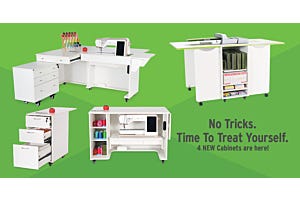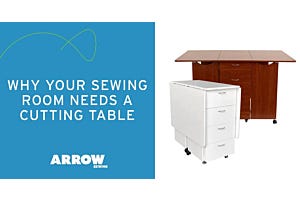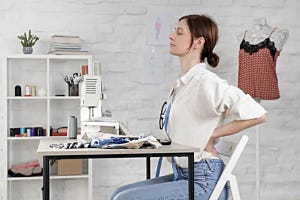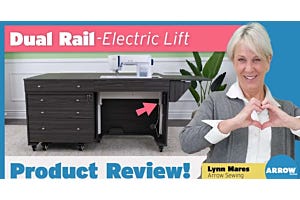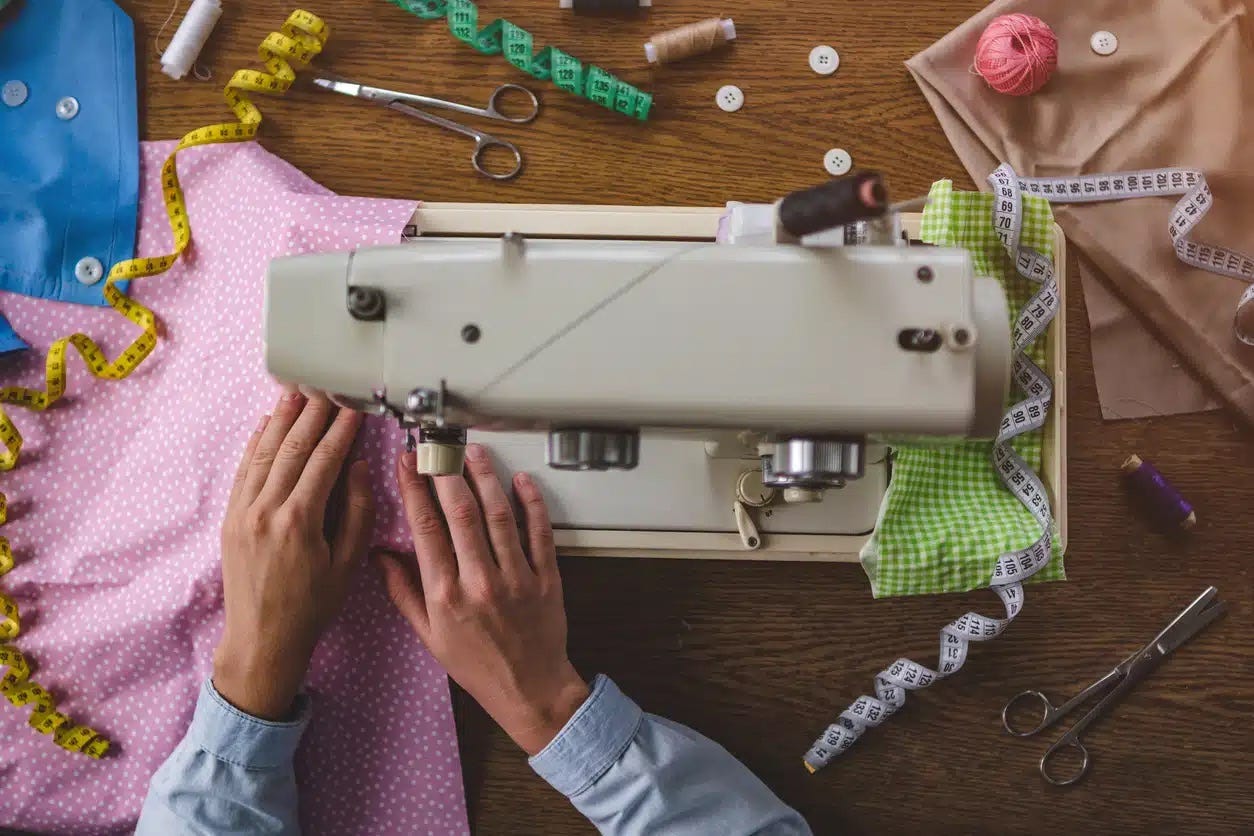
If you’ve never sewn before, choosing the right sewing machine to learn on can feel like learning another language. You may not know what to look for in a sewing machine or how much you can expect to pay for one. However, choosing the best sewing machine marks the beginning of a fun and fulfilling new hobby.
Whether you're eager to create your own unique fashion pieces, mend beloved garments, or craft beautiful home décor, learning to sew opens the door to endless creative possibilities.
With a dizzying array of options available in today's market, finding the perfect companion for your sewing adventures requires some preliminary research. In this comprehensive guide, we've done the legwork for you and have included a curated selection of the best sewing machines designed with beginners in mind.
Whether you're a complete novice or someone returning to the craft after a hiatus, our recommendations will help you make an informed decision, ensuring that your sewing experience is enjoyable and successful.
Understanding the Needs of a Beginner Sewist
You want to pick a great sewing machine, but a sewing machine that’s great for professional sewists may not be best if you don’t know a bobbin from a buttonhole. When choosing your first sewing machine, there are several factors to consider besides speed, cost, and size.
First and foremost, your first machine should boast a user-friendly design featuring an interface free from complex controls and technical jargon. A simple machine with intuitive controls prevents you from feeling overwhelmed by too many options and settings.
You also want to know that your machine will create consistent stitches, even while you’re learning. Beginners can become disheartened when their stitches turn out uneven or irregular. Therefore, sewing machines tailored for novices prioritize delivering reliable, even stitches to build confidence and motivation.
Comprehensive support and learning resources, such as user manuals and tutorials, are invaluable when you’re new to sewing. Buying a machine from a big-name brand like Singer or Brother will mean that you can access a wealth of tutorials and specialized instructions specific to your machine.
Lastly, safety features, including finger guards and automatic thread cutters, minimize the risk of accidents, ensuring a secure and enjoyable sewing experience. It’s hard to learn if your fingers get poked every few stitches! By researching your needs and finding a beginner-friendly sewing machine, you’re setting yourself up to succeed as a beginner sewist.
Criteria for Selecting the Best Sewing Machine
So, how do you determine what makes a great sewing machine? Well, that’s easier said than done - your preferences for sewing machines depend significantly on your needs. But here are some criteria to consider.
First off, budget. If you’re confident you will use your sewing machine for years, you may choose to splurge on a more expensive model. However, if you’re just trying out sewing as a hobby, you may purchase a machine that costs less than $100. It’s important to remember that while simple and inexpensive models can save you money in the short term, they feature fewer stitches and features, and you may find yourself upgrading sooner rather than later.
Versatility is another important aspect of your ideal sewing machine. While you may start with only basic stitches, the ability to grow and tackle more intricate projects opens up a realm of sewing possibilities. Opting for a machine that offers a variety of stitches and customizable options ensures that your sewing machine will remain relevant and valuable as your skills progress.
Accessories and add-ons are often overlooked but can significantly enhance your sewing experience. Consider whether the machine comes with essential accessories like multiple presser feet, a selection of needles, and a seam ripper. Additionally, assess the availability of compatible add-ons and attachments, such as quilting or walking feet, to expand your sewing capabilities. These accessories can save time and offer new creative possibilities.
Lastly, determine your machine's ideal size and weight to ensure that it fits seamlessly into your workspace and lifestyle. A compact and lightweight machine may be more suitable for those with limited space or who need to transport their machine frequently. Conversely, a larger, sturdier machine might be preferable for dedicated sewing rooms.
Different Types of Sewing Machines
There are multiple types of sewing machines, all with different features and functionalities. Let’s demystify some of these terms now.
Mechanical Sewing Machine
Mechanical sewing machines are the traditional workhorses of the sewing world. They operate purely through mechanical components and manual controls, lacking electronic or computerized features. These machines are known for their durability and simplicity, making them an excellent choice for beginners. With basic stitch options and straightforward operation, mechanical sewing machines are ideal for everyday sewing tasks, repairs, and simple projects.
Computerized Sewing Machine
In contrast to mechanical machines, computerized sewing machines operate with advanced technology and electronic controls. They offer a wide range of stitch options, adjustable settings, and often feature digital displays for ease of use. Computerized machines are prized for their precision and efficiency, making them suitable for both beginners and experienced sewists who desire versatility and automation in their projects.
Embroidery Machines
Embroidery machines are designed to create intricate and decorative designs on fabric. These machines use computerized technology to digitize and replicate complex embroidery patterns. They often come with a variety of built-in designs and allow for customization. Embroidery machines are a favorite among those who enjoy embellishing clothing, accessories, and home decor items with intricate embroidery.
Quilting Machines
Quilting machines are specialized sewing machines explicitly tailored for the art of quilting. These machines are designed to handle the unique demands of quilting projects, which often involve multiple layers of fabric and intricate stitching patterns.
Quilting machines come equipped with a larger working area or an extended throat space, allowing for easier manipulation of quilts. They feature various quilting stitches and accessories like walking feet and quilting guides to help users create precise and evenly spaced quilting lines.
Many quilting machines also have the option to attach a quilting frame or table for added stability and control during large quilting projects. These machines make quilting more efficient, enjoyable, and precise.
Sergers - Overlock Machines
Sergers, or overlock machines, are specialized sewing machines primarily used for finishing edges and creating neat, professional-looking seams. These machines are designed to trim excess fabric and simultaneously stitch the edges to prevent fraying. Sergers are indispensable for garment construction and achieving clean, durable seams on knit fabrics.
Coverstitch Machines
Coverstitch machines are another specialized sewing tool used primarily for hemming and decorative stitching on knit garments. They create a double-line stitch on the top side of the fabric with a looper thread on the back, resembling the look of store-bought, ready-to-wear clothing. Coverstitch machines are favored for providing a polished finish to the hems of T-shirts, leggings, and other stretchy garments, enhancing their professional appearance.
How Much Should You Spend on a Beginner Sewing Machine?
Determining your budget for a sewing machine involves assessing your sewing aspirations and the financial commitment you're comfortable with.
For beginners looking to explore sewing as a hobby, a budget of around $100 to $200 can suffice for a basic, entry-level sewing machine with essential features. If you anticipate sewing becoming a regular part of your life or have specific projects in mind, allocating between $200 to $500 opens up a range of mid-range sewing machines that offer more versatility and durability.
For those with professional ambitions or complex sewing projects in mind, investing upwards of $500 to $1,000 or more allows access to top-of-the-line machines with advanced features and impeccable performance. Tailoring your budget to your sewing goals ensures that you make a satisfying choice and achieve the best value for your investment in the sewing world.
Top 5 Sewing Machines for Beginners
Here is a list of the top 5 sewing machines for beginners that Arrow Sewing recommends.
Best Overall: Brother ST371HD "Strong & Tough"
Brother is a heavyweight brand among sewing machine manufacturers, and the ST371HD “Strong and Tough” is an example of why. Designed to handle heavyweight fabrics easily, this machine is perfect for those learning to sew or tackling heavy-duty projects. It offers many creative possibilities with 37 built-in stitches, including essential utility and decorative options.
Its user-friendly interface sets the Brother ST371HD apart, making it exceptionally beginner-friendly. Threading is simplified with a top drop-in bobbin system, and the automatic needle threader saves time and frustration. The machine's sturdy build ensures long-term reliability, while the free-arm design makes sewing cuffs, sleeves, and other cylindrical items effortless.
At $220, this sewing machine is on the low end for cost and is therefore accessible to sewists on a budget. This machine will last you several years with good maintenance and upkeep!
Best Portable Machine: Haitral Mini
At only 8 inches wide and with a $30 price tag, the Haitral Mini is attractive to beginners, children, and travelers alike. Weighing in at just a few pounds, this machine is incredibly easy to transport and store, making it an ideal choice for sewing classes, travel, or small living spaces.
Despite its portability, this machine doesn't compromise on functionality. It offers essential features like multiple stitch options, dual speed settings, and a convenient thread cutter. Beginners will appreciate its simplicity and ease of use, making it a fantastic starting point for those new to sewing.
However, if you want to take on more complex projects or work with a larger machine, you will have to upgrade to something more substantial. The Haitral can also be an excellent supplement to a larger sewing machine.
Best Budget Pick: Singer Start 1304
The Singer Start 1304 is aptly named as an ideal starter sewing machine. At only $160, this machine is well-suited for beginners still learning stitching and hemming basics. Its straightforward design and easy-to-follow instructions make it incredibly user-friendly, making it an excellent choice for those new to sewing.
Despite its budget-friendly price tag, the Singer Start 1304 doesn't skimp on essential features. It offers a variety of basic stitches, adjustable stitch length and width, and a convenient built-in bobbin winding system. Whether tackling simple alterations or exploring creative sewing projects, this machine provides a solid foundation. Its sturdy build and reliability ensure it will serve you well for years, making it the perfect choice for beginner sewists seeking a cost-effective and dependable sewing companion.
Best Quilting Machine: Brother XR9550
If beautiful quilts and blankets drew you to sewing in the first place, you should invest in a quilting machine right off the bat. The Brother XR9550 is the best beginner quilting machine, as it is budget-friendly at $220 and has a host of specialized stitches available. It provides ample creative potential with 185 built-in stitches, including a selection of quilting stitches.
Its user-friendly computerized interface sets the Brother HC1850 apart, making it remarkably accessible for beginners. It offers an automatic needle threader, a drop-in bobbin system, and an LCD screen for easy stitch selection. The wide table extension provides ample space for maneuvering quilts, ensuring smooth and precise stitching.
This machine also has a detachable quilting guide and walking foot, which is essential for achieving professional-looking quilting patterns. With the Brother XR9550, beginner sewists can confidently embark on quilting adventures, creating stunning quilts quickly and precisely.
Best Computerized Machine: Janome C30 Computerized Sewing Machine
Computerized sewing machines are impressive inventions that help sewists to innovate and invent, and the Janome C30 is no exception. At $350, it’s on the higher end of the beginner sewing machine price range, but it’s certainly worth it. With its intuitive interface and user-friendly features, this machine is tailor-made for those new to sewing. The C30 boasts a wide range of 30 built-in stitches, allowing beginners to explore various sewing projects.
What sets the Janome C30 apart is its modern computerized capabilities. It features an easy-to-navigate LCD screen for stitch selection and customization, making it a breeze for novices to experiment with different styles and settings. The automatic needle threader, jam-proof top-loading bobbin system, and adjustable stitch length and width further simplify the sewing process.
Its compact and lightweight design adds to its user-friendliness, making it a portable sewing companion that can be easily moved and stored. Whether you're sewing garments, home decor, or quilts, the Janome C30 empowers beginners to unleash their creativity with cutting-edge technology, making it the best choice for computerized sewing machines tailored to beginners.
Easiest Machine to Thread: Brother XM2701
Threading your machine’s needle is a sore spot for sewists of all skill levels - so it makes sense to buy a machine based on how easy it is to thread. The Brother XM2701 is a machine designed for absolute beginners, but it doesn’t compromise on features or aesthetics. This machine features an automatic needle threader, which takes the frustration out of threading the needle by automatically pulling the thread through the eye with a quick lever motion.
Additionally, the Brother XM2701 employs a jam-resistant top drop-in bobbin system, ensuring that winding and inserting the bobbin is a straightforward procedure. Its numbered diagram instructions guide users through the thread path, eliminating confusion and minimizing the learning curve. These thoughtful design elements make the XM2701 the ideal choice for beginners seeking a sewing machine that minimizes the initial setup challenges, allowing you to dive straight into creative projects easily and confidently.
Sewing Accessories for Beginners
Of course, you’ll need to round out your sewing station with some vital accessories. Here are the additional tools you’ll want to use as your skills grow.
Presser Feet
Presser feet are a diverse set of accessories designed to enhance the functionality of sewing machines. Each presser foot serves a unique purpose, from standard presser feet for basic stitches to specialized feet like zipper feet, buttonhole feet, and blind hem feet. These attachments ensure precise and controlled fabric feeding, allowing users to tackle various sewing tasks. Presser feet are indispensable for achieving professional results and expanding the creative potential of sewing machines.
Quilting Guide
A quilting guide is a valuable accessory for quilting enthusiasts. It attaches to the presser foot and helps maintain even spacing between rows of quilting stitches. Quilting guides are handy for free-motion quilting, enabling users to create intricate and decorative patterns on quilts and other projects with precision and consistency.
Darning Plate
A darning plate, or a free-motion or embroidery plate, is a removable accessory used for free-motion sewing and embroidery. It covers the sewing machine's feed dogs, allowing users to control the fabric's movement manually. This accessory is essential for creative embroidery work, free-motion quilting, and repairing fabric tears or holes.
Extension Table
An extension table is an attachment that provides an additional workspace for sewing large or bulky projects. It attaches to the sewing machine, creating a flat, stable surface to support quilts, curtains, and other oversized items. Extension tables ensure smoother fabric handling and more precise stitching when working on extensive projects.
Walking Foot
A walking foot, also known as an even feed foot, is a specialized presser foot designed to feed multiple layers of fabric evenly. It prevents fabric layers from shifting or puckering, making it indispensable for sewing thick or slippery materials like leather, vinyl, or quilting layers. This accessory is particularly valuable when working on projects requiring precise pattern matching or quilting through multiple layers of fabric and batting.
Set Your Space for Success
In the world of sewing, the choices are as diverse as the creative possibilities they offer. Whether you’re a beginner sewist or returning to the hobby after a long hiatus, finding the machine suitable to your needs can significantly enhance your sewing journey.
Remember that the best sewing machine or accessory is the one that aligns seamlessly with your goals and preferences. By contemplating factors such as budget, ease of use, versatility, durability, available add-ons, and size, you can choose to elevate your sewing experience.
Once you’ve picked the sewing machine that’s best for you, you’ll need a place to store it! That’s where Arrow Sewing comes in. We offer a wide selection of sewing furniture designed with your specialized needs in mind. Whether you need a table with robust storage or an ergonomic sewing chair in a bright pattern, we have what you need. Check out our product catalog today!




